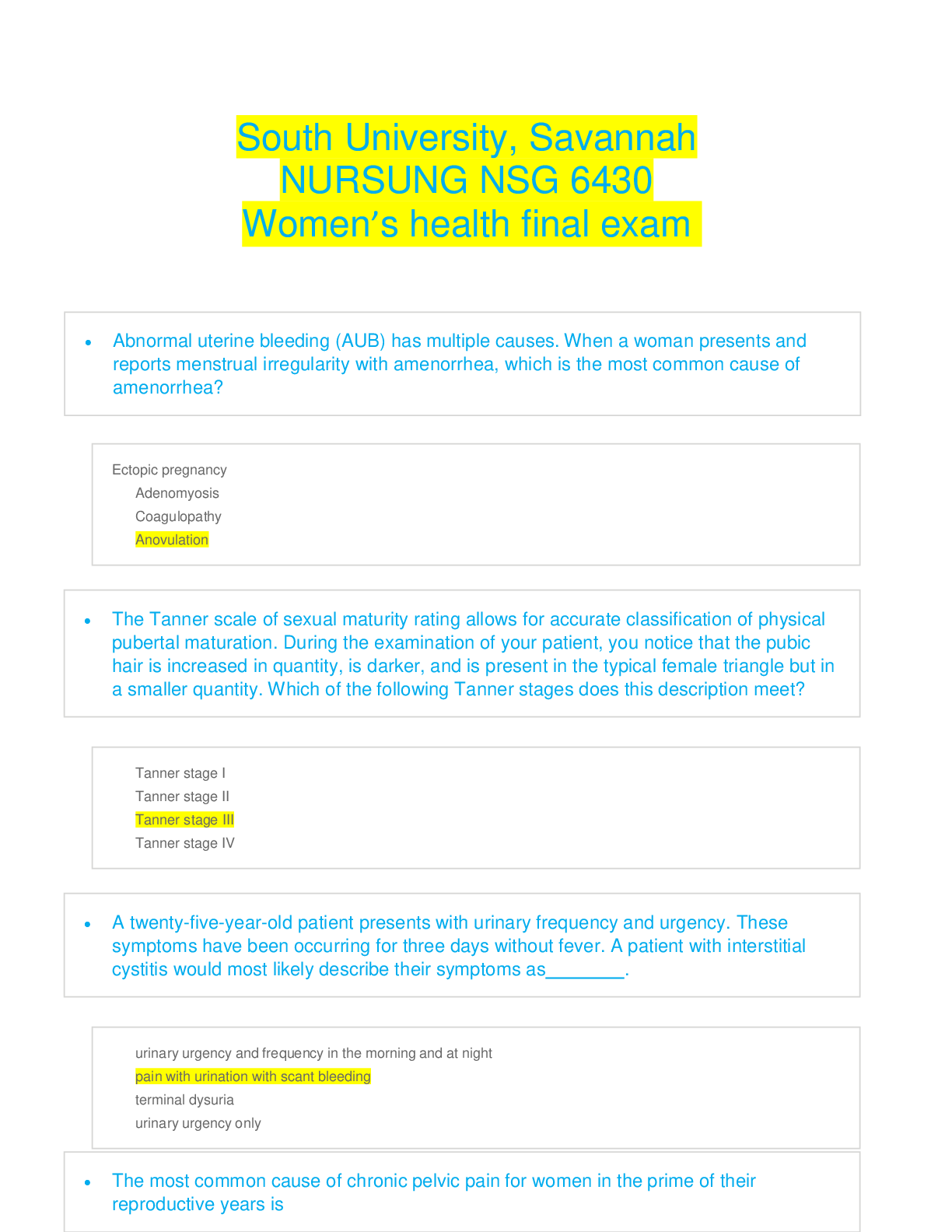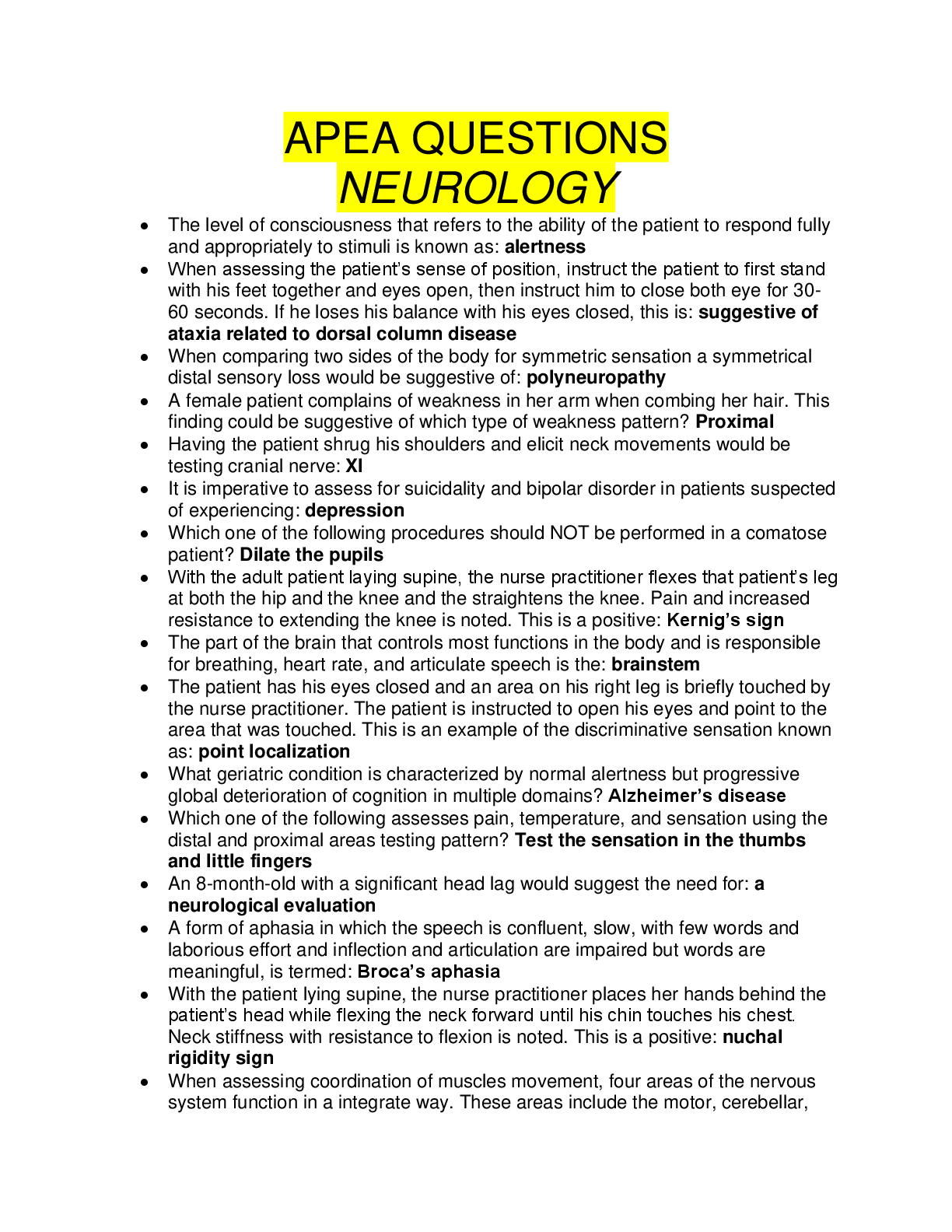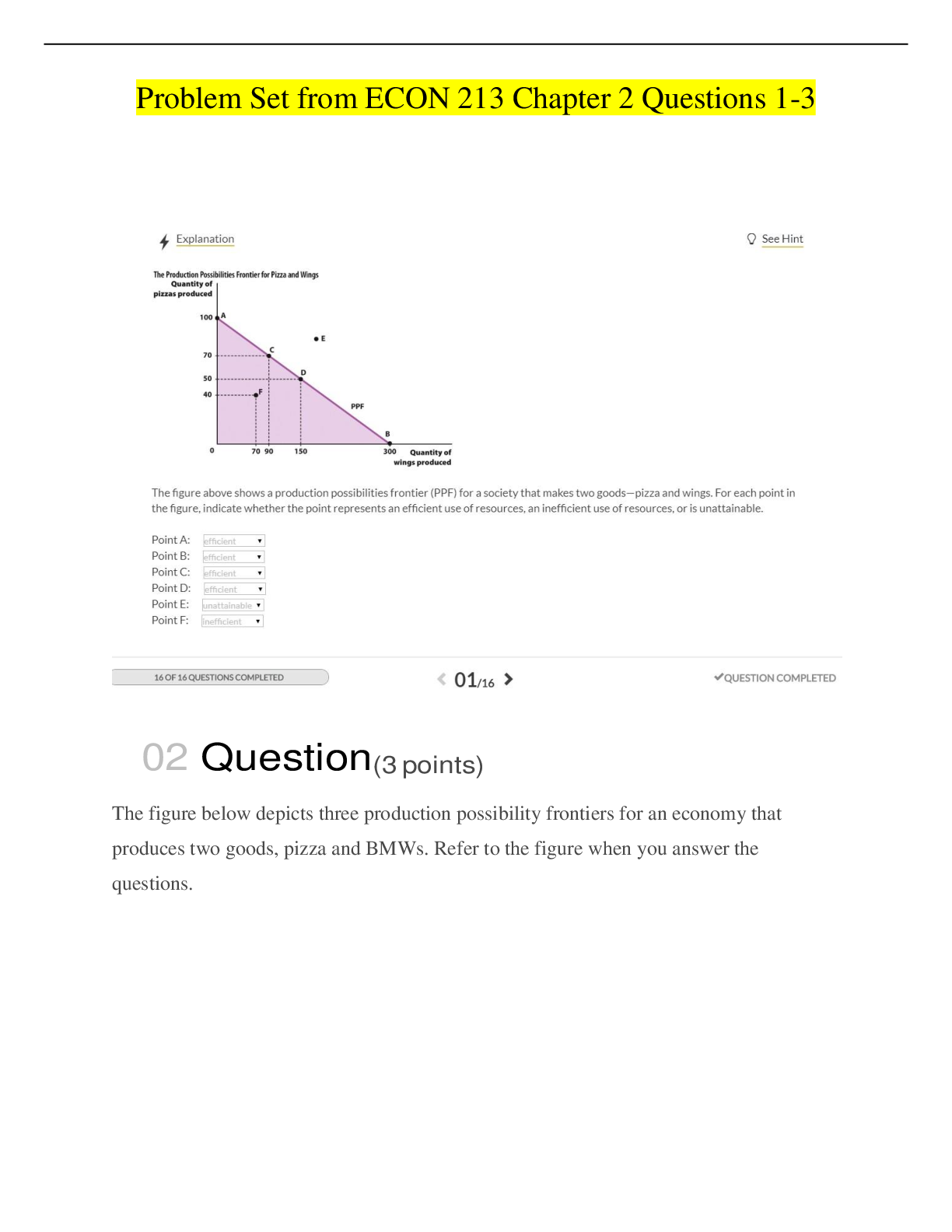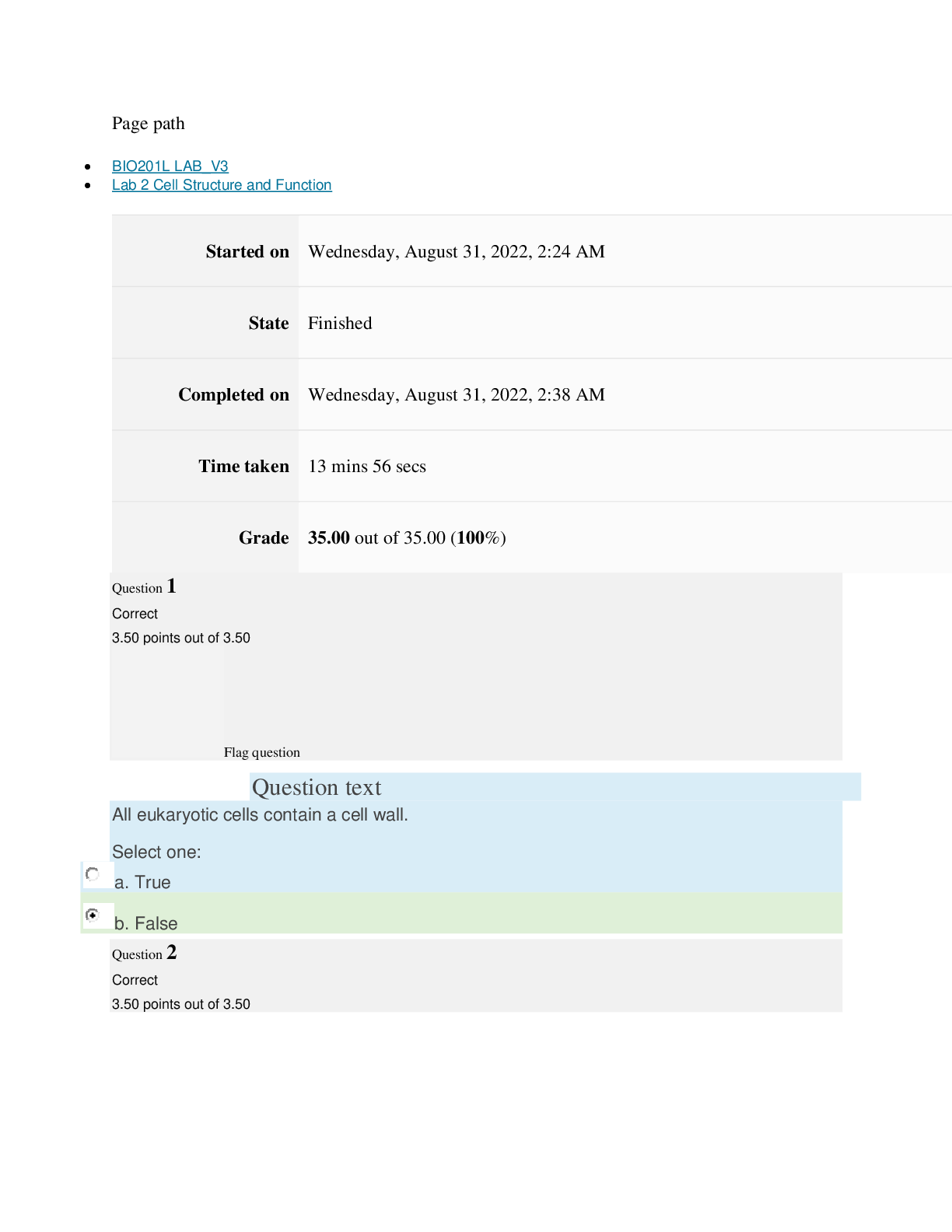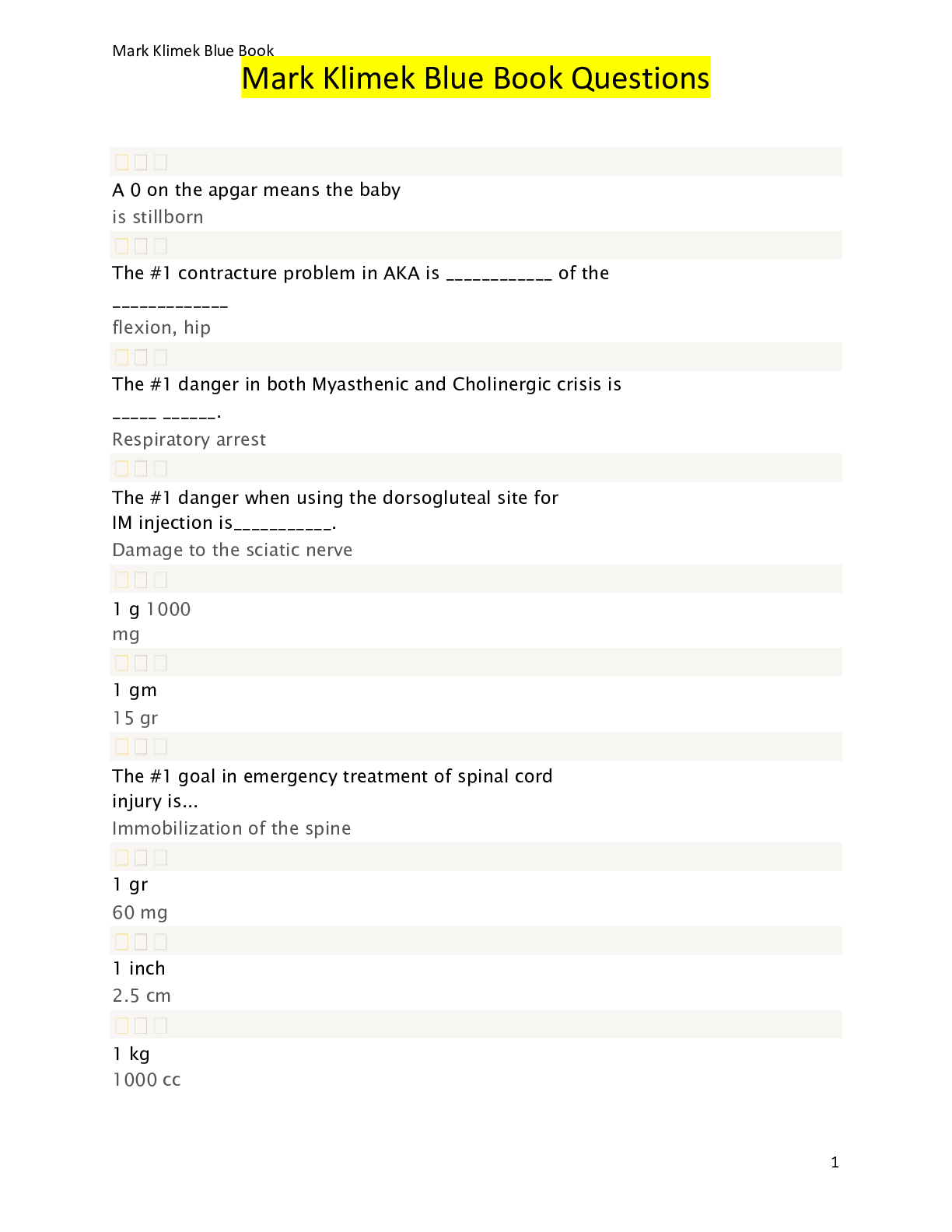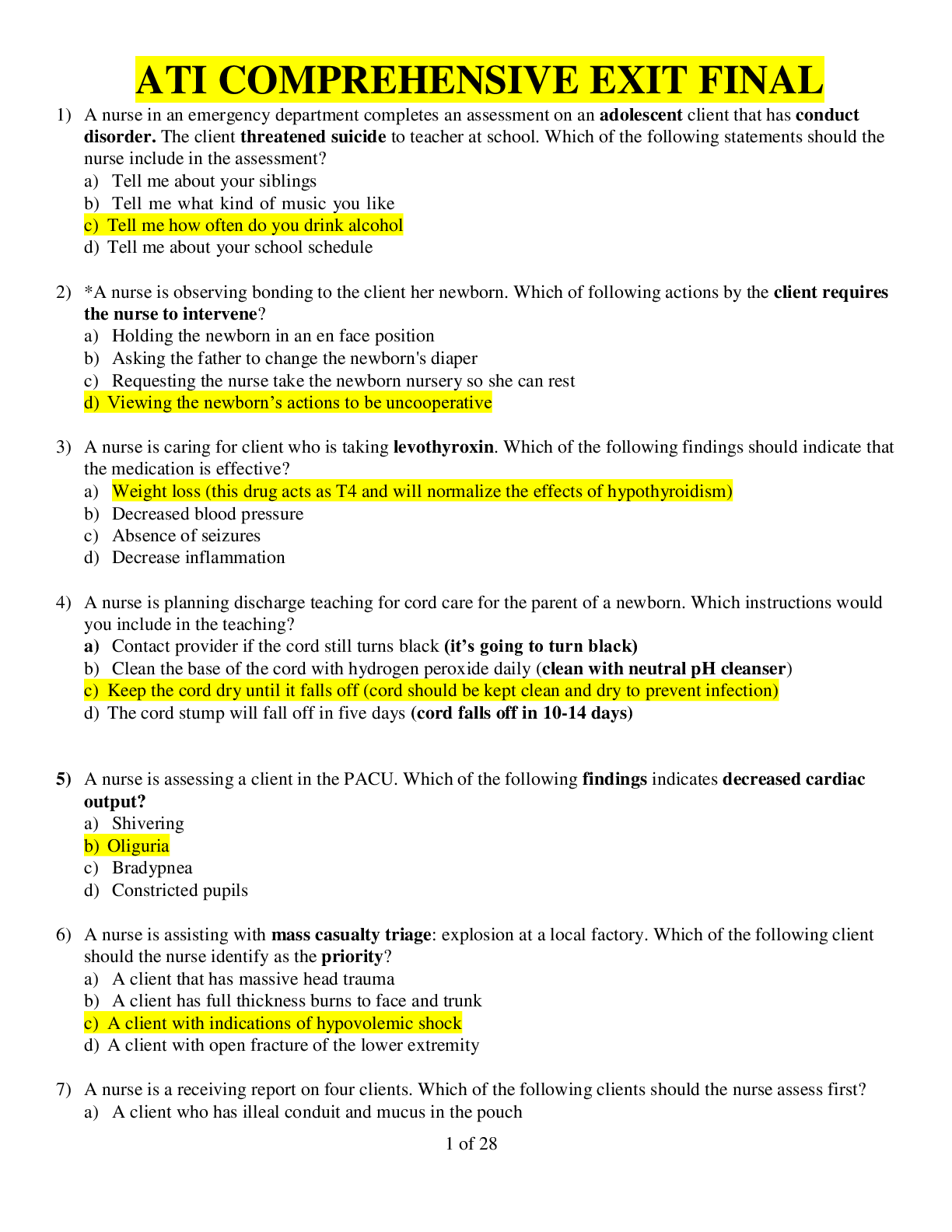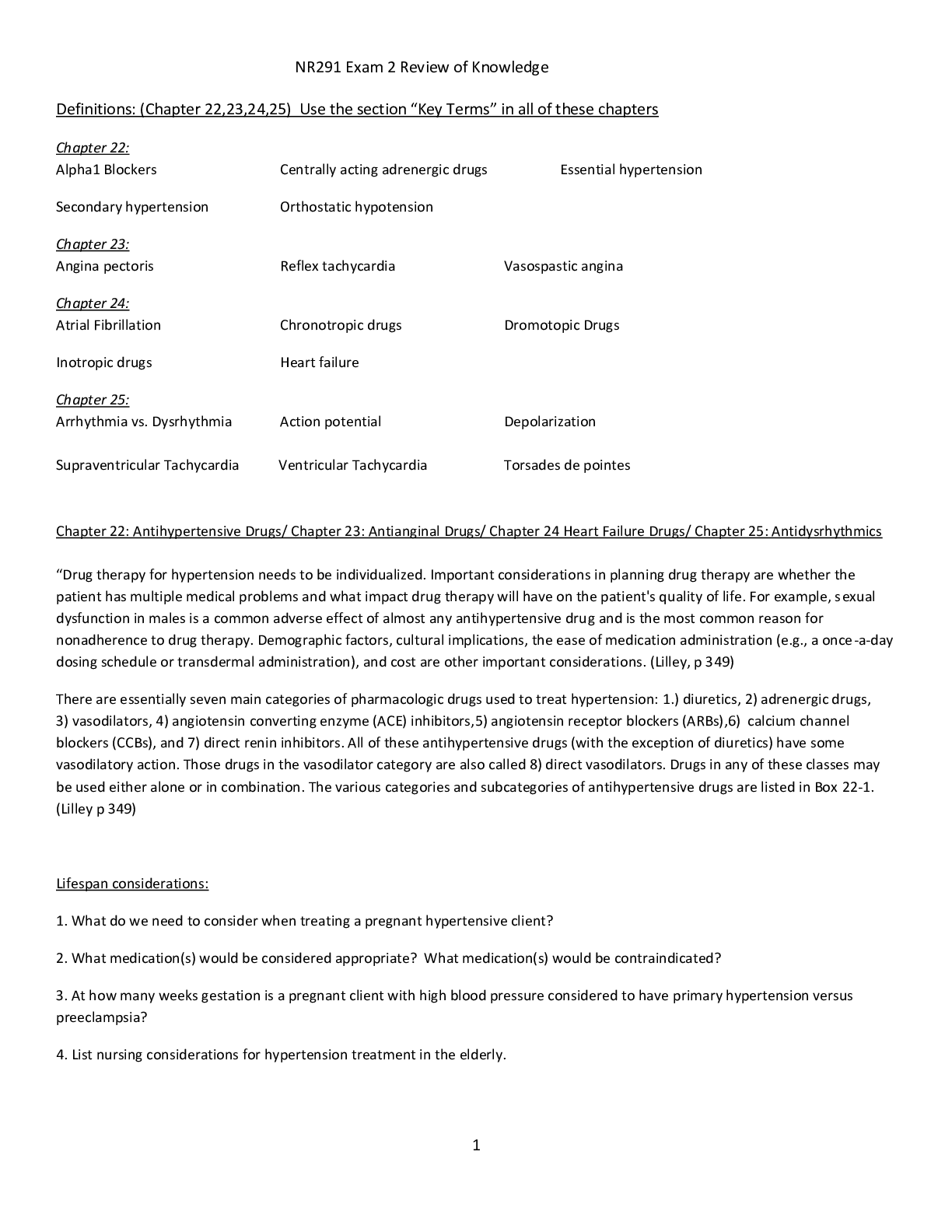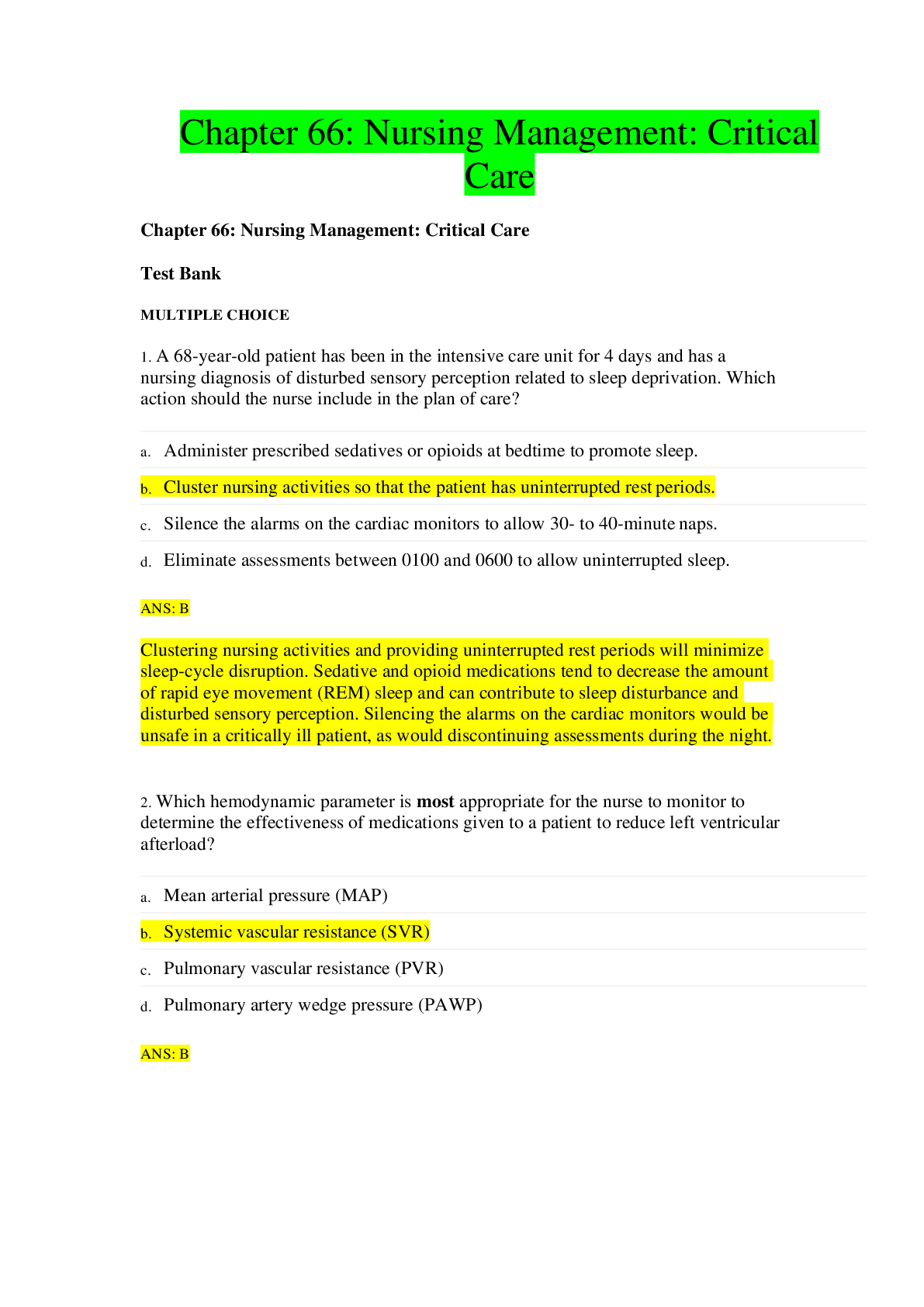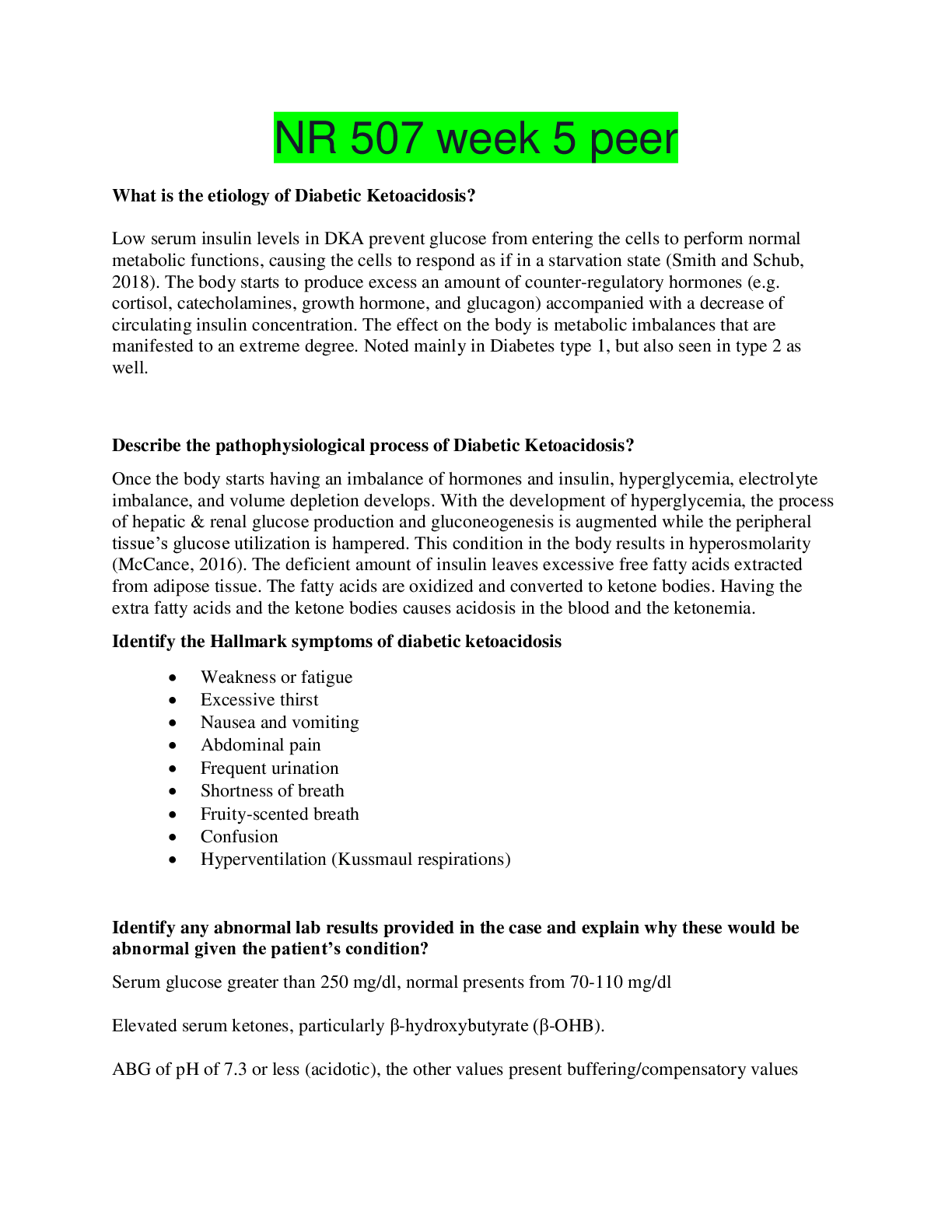*NURSING > QUESTIONS & ANSWERS > Chamberlain College Of Nursing > NURSING > NURSING 324. NR 324. Chapter 69: Nursing Management: Emer (All)
Chamberlain College Of Nursing > NURSING > NURSING 324. NR 324. Chapter 69: Nursing Management: Emergency, Terrorism, and Disaster Nursing (GRADED A)
Document Content and Description Below
Chapter 69: Nursing Management: Emergency, Terrorism, and Disaster Nursing Chapter 69: Nursing Management: Emergency, Terrorism, and Disaster Nursing Test Bank MULTIPLE CHOICE 1. During the ... primary assessment of a victim of a motor vehicle collision, the nurse determines that the patient is breathing and has an unobstructed airway. Which action should the nurse take next? a. Palpate extremities for bilateral pulses. b. Observe the patient’s respiratory effort. c. Check the patient’s level of consciousness. d. Examine the patient for any external bleeding. 2. During the primary survey of a patient with severe leg trauma, the nurse observes that the patient’s left pedal pulse is absent and the leg is swollen. Which action will the nurse take next? a. Send blood to the lab for a complete blood count. b. Assess further for a cause of the decreased circulation. c. Finish the airway, breathing, circulation, disability survey. d. Start normal saline fluid infusion with a large-bore IV line. 3. After the return of spontaneous circulation following the resuscitation of a patient who had a cardiac arrest, therapeutic hypothermia is ordered. Which action will the nurse include in the plan of care? a. Apply external cooling device. b. Check mental status every 15 minutes. c. Avoid the use of sedative medications. d. Rewarm if temperature is <91° F (32.8° C). 4. A patient who is unconscious after a fall from a ladder is transported to the emergency department by emergency medical personnel. During the primary survey of the patient, the nurse should a. obtain a complete set of vital signs. b. obtain a Glasgow Coma Scale score. c. ask about chronic medical conditions. d. attach a cardiac electrocardiogram monitor. A 19-year-old is brought to the emergency department (ED) with multiple lacerations and tissue avulsion of the left hand. When asked about tetanus immunization, the patient denies having any previous vaccinations. The nurse will anticipate giving a. tetanus immunoglobulin (TIG) only. b. TIG and tetanus-diphtheria toxoid (Td). c. tetanus-diphtheria toxoid and pertussis vaccine (Tdap) only. d. TIG and tetanus-diphtheria toxoid and pertussis vaccine (Tdap). 5. A patient who has experienced blunt abdominal trauma during a motor vehicle collision is complaining of increasing abdominal pain. The nurse will plan to teach the patient about the purpose of a. peritoneal lavage. b. abdominal ultrasonography. c. nasogastric (NG) tube placement. d. magnetic resonance imaging (MRI). 6. A patient with hypotension and an elevated temperature after working outside on a hot day is treated in the emergency department (ED). The nurse determines that discharge teaching has been effective when the patient makes which statement? a. “I will take salt tablets when I work outdoors in the summer.” b. “I should take acetaminophen (Tylenol) if I start to feel too warm.” c. “I should drink sports drinks when working outside in hot weather.” d. “I will move to a cool environment if I notice that I am feeling confused.” 7. A 22-year-old patient who experienced a near drowning accident in a local pool, but now is awake and breathing spontaneously, is admitted for observation. Which assessment will be mostimportant for the nurse to take during the observation period? a. Auscultate heart sounds. b. Palpate peripheral pulses. c. Auscultate breath sounds. d. Check pupil reaction to light. 8. When planning the response to the potential use of smallpox as an agent of terrorism, the emergency department (ED) nurse manager will plan to obtain adequate quantities of a. vaccine. b. atropine. c. antibiotics. d. whole blood. 9. When rewarming a patient who arrived in the emergency department (ED) with a temperature of 87° F (30.6° C), which assessment indicates that the nurse should discontinue active rewarming? a. The patient begins to shiver. b. The BP decreases to 86/42 mm Hg. c. The patient develops atrial fibrillation. d. The core temperature is 94° F (34.4° C). 10. When assessing an older patient admitted to the emergency department (ED) with a broken arm and facial bruises, the nurse observes several additional bruises in various stages of healing. Which statement or question by the nurse is most appropriate? a. “Do you feel safe in your home?” b. “You should not return to your home.” c. “Would you like to see a social worker?” d. “I need to report my concerns to the police.” 11. A 20-year-old patient arrives in the emergency department (ED) several hours after taking “25 to 30” acetaminophen (Tylenol) tablets. Which action will the nurse plan to take? a. Give N-acetylcysteine (Mucomyst). b. Discuss the use of chelation therapy. c. Start oxygen using a non-rebreather mask. d. Have the patient drink large amounts of water. 12. A triage nurse in a busy emergency department (ED) assesses a patient who complains of 7/10 abdominal pain and states, “I had a temperature of 103.9° F (39.9° C) at home.” The nurse’s firstaction should be to a. assess the patient’s current vital signs. b. give acetaminophen (Tylenol) per agency protocol. c. ask the patient to provide a clean-catch urine for urinalysis. d. tell the patient that it will 1 to 2 hours before being seen by the doctor. 13. The emergency department (ED) triage nurse is assessing four victims involved in a motor vehicle collision. Which patient has the highest priority for treatment? a. A patient with no pedal pulses. b. A patient with an open femur fracture. c. A patient with bleeding facial lacerations. d. A patient with paradoxic chest movements. ANS: D Most immediate deaths from trauma occur because of problems with ventilation, so the patient with paradoxic chest movements should be treated first. Face and head fractures can obstruct the airway, but the patient with facial injuries only has lacerations. The other two patients also need rapid intervention but do not have airway or breathing problems. 14. The following interventions are part of the emergency department (ED) protocol for a patient who has been admitted with multiple bee stings to the hands. Which action should the nurse takefirst? a. Remove the patient’s rings. b. Apply ice packs to both hands. c. Apply calamine lotion to any itching areas. d. Give diphenhydramine (Benadryl) 50 mg PO. 15. Gastric lavage and administration of activated charcoal are ordered for an unconscious patient who has been admitted to the emergency department (ED) after ingesting 30 lorazepam (Ativan) tablets. Which action should the nurse plan to do first? a. Insert a large-bore orogastric tube. b. Assist with intubation of the patient. c. Prepare a 60-mL syringe with saline. d. Give first dose of activated charcoal. 16. A 54-year-old patient arrives in the emergency department (ED) after exposure to powdered lime at work. Which action should the nurse take first? a. Obtain the patient’s vital signs. b. Obtain a baseline complete blood count. c. Decontaminate the patient by showering with water. d. Brush off any visible powder on the skin and clothing. 17. An unresponsive 79-year-old is admitted to the emergency department (ED) during a summer heat wave. The patient’s core temperature is 105.4° F (40.8° C), blood pressure (BP) 88/50, and pulse 112. The nurse initially will plan to a. apply wet sheets and a fan to the patient. b. provide O2 at 6 L/min with a nasal cannula. c. start lactated Ringer’s solution at 1000 mL/hr. d. give acetaminophen (Tylenol) rectal suppository. 18. A patient is admitted to the emergency department (ED) after falling through the ice while ice skating. Which assessment will the nurse obtain first? a. Heart rate b. Breath sounds c. Body temperature d. Level of consciousness 19. Following an earthquake, patients are triaged by emergency medical personnel and are transported to the emergency department (ED). Which patient will the nurse need to assess first? a. A patient with a red tag b. A patient with a blue tag c. A patient with a black tag d. A patient with a yellow tag 20. Family members are in the patient’s room when the patient has a cardiac arrest and the staff start resuscitation measures. Which action should the nurse take next? Keep the family in the room and assign a staff member to explain the care given and answer a. questions. Ask the family to wait outside the patient’s room with a designated staff member to provide b. emotional support. Ask the family members about whether they would prefer to remain in the patient’s room or c. wait outside the room. Tell the family members that patients are comforted by having family members present d. during resuscitation efforts. 21. A 28-year-old patient who has deep human bite wounds on the left hand is being treated in the urgent care center. Which action will the nurse plan to take? a. Prepare to administer rabies immune globulin (BayRab). b. Assist the health care provider with suturing of the bite wounds. c. Teach the patient the reason for the use of prophylactic antibiotics. d. Keep the wounds dry until the health care provider can assess them. ANS: C Because human bites of the hand frequently become infected, prophylactic antibiotics are usually prescribed to prevent infection. To minimize infection, deep bite wounds on the extremities are left open. Rabies immune globulin might be used after an animal bite. Initial treatment of bite wounds includes copious irrigation to help clean out contaminants and microorganisms. 22. The urgent care center protocol for tick bites includes the following actions. Which action will the nurse take first when caring for a patient with a tick bite? a. Use tweezers to remove any remaining ticks. b. Check the vital signs, including temperature. c. Give doxycycline (Vibramycin) 100 mg orally. d. Obtain information about recent outdoor activities. MULTIPLE RESPONSE 1. When preparing to cool a patient who is to begin therapeutic hypothermia, which intervention will the nurse plan to do (select all that apply)? a. Assist with endotracheal intubation. b. Insert an indwelling urinary catheter. c. Begin continuous cardiac monitoring. d. Obtain an order to restrain the patient. e. Prepare to give sympathomimetic drugs. 2. The emergency department (ED) nurse is initiating therapeutic hypothermia in a patient who has been resuscitated after a cardiac arrest. Which actions in the hypothermia protocol can be delegated to an experienced licensed practical/vocational nurse (LPN/LVN) (select all that apply)? a. Continuously monitor heart rhythm. b. Check neurologic status every 2 hours. c. Place cooling blankets above and below patient. d. Give acetaminophen (Tylenol) 650 mg per nasogastric tube. e. Insert rectal temperature probe and attach to cooling blanket control panel. The following four patients arrive in the emergency department (ED) after a motor vehicle collision. In which order should the nurse assess them? (Put a comma and a space between each answer choice [A, B, C, D, E].) A 74-year-old with palpitations and chest pain a. A 43-year-old complaining of 7/10 abdominal pain b. A 21-year-old with multiple fractures of the face and jaw c. A 37-year-old with a misaligned left leg with intact pulses [Show More]
Last updated: 2 years ago
Preview 1 out of 13 pages
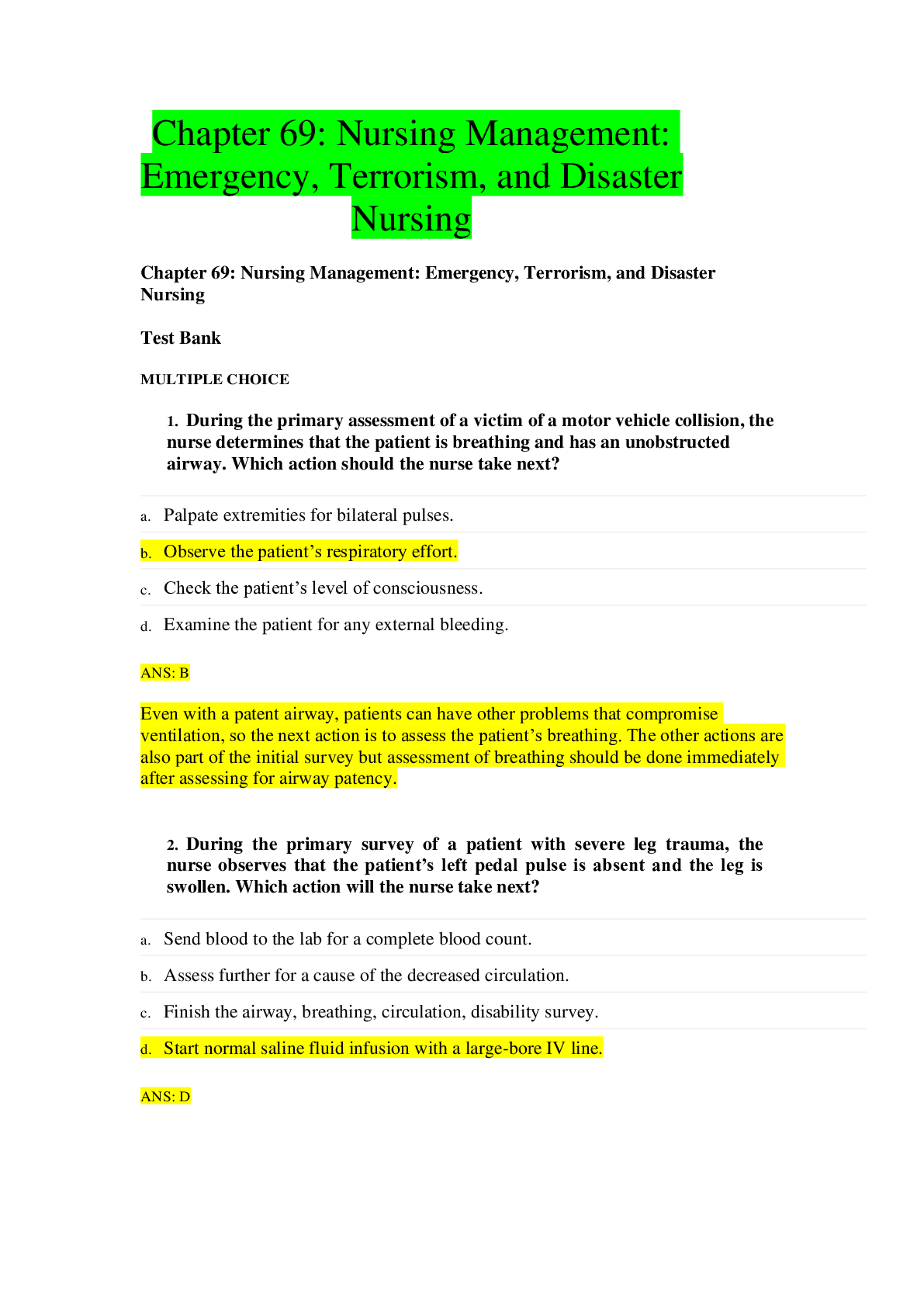
Buy this document to get the full access instantly
Instant Download Access after purchase
Buy NowInstant download
We Accept:

Reviews( 0 )
$10.00
Can't find what you want? Try our AI powered Search
Document information
Connected school, study & course
About the document
Uploaded On
Apr 22, 2020
Number of pages
13
Written in
Additional information
This document has been written for:
Uploaded
Apr 22, 2020
Downloads
0
Views
82

